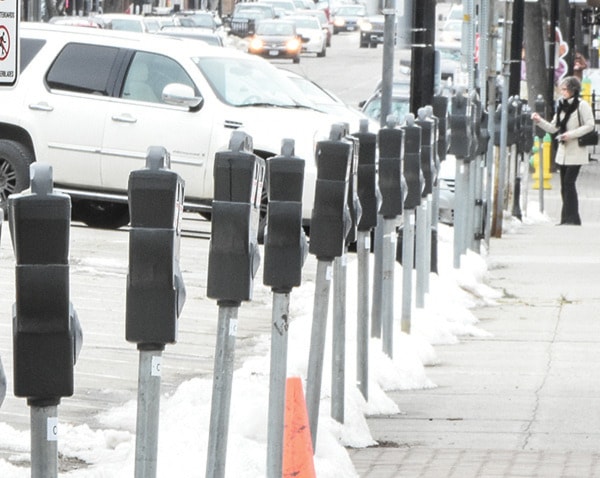The City of Penticton is easing off on its plans to introduce pay parking in major parks and recreational areas, but they are not giving up on the overall plan.
The new plan removes Skaha Lake Park from the work plan and limits pay parking to the commercial area of Lakeshore Drive, west of the Power Street intersection, up to and including the SS Sicamous and the parking lot in front of Loco Landing parking lot. Skaha Lake and the remaining portion of Lakeshore Drive will remain as options for expanding the pay parking program at a later stage.
To date, there has been little formal consultation with the public about the pay parking strategy, including the businesses in the area covered by the new plan.
“We certainly talked to a lot of the business owners along lakeshore. But we haven’t done any real, formal consultation with them,” said Blake Laven, city planning manager.
Diana Stirling, owner of the LocoLanding Adventure Park, said she was only informed on Sept. 3 that the lot in front of her business, which also serves the Rose Garden and the SS Sicamous, would be converted to pay parking in mid-September.
“I was disappointed in the fact that we had not been consulted about this. I wish that we would have had more knowledge,” said Stirling, who consulted with other stakeholders including the Sicamous and Salty’s Beach House. “None of us knew that it was going before council. We haven’t been able to form an opinion, because we don’t know how this is going to roll out.”
Stirling said it is hard to say how pay parking will affect her business, which employs about 70 people over the summer season. She wishes the situation could be different, but understands the economic realities facing the city driving the pay parking strategy.
“As a business that is working so hard to bring locals and tourists to that part of town, we just would have liked inclusion. I just feel like we are a little bit behind,” she said.
A tourist on their way to the beach, LocoLanding, or the Sicamous isn’t likely to change their mind based on having to pay parking. It’s the return visit, said Stirling, that might change.
“One of the unique things about Penticton is that we are so accessible. Time almost stands still for us, when you are a tourist. The thought of people having to think about the time on the meter or getting a ticket, or staying longer because they are having so much fun and getting a ticket, completely changes the experience,” said Stirling. “There is a chance that we have taken away that experience they are currently having. We don’t know what that change then means.”
Many other tourist destinations have pay parking, Stirling concedes, but that shouldn’t be justification for the City of Penticton adopting the strategy.
“I don’t believe that just because somebody else in some other cities are doing it, it is OK for us to do it,” said Stirling. “I always feel like we should be different, we should be unique. This is maybe one of those things. What we have is amazing right now, along the lakefront, the fact that people can park in our lot and we are not continually asking them for money.”
The parking strategy was first introduced in 2012, with the 2016-17 work plan endorsed by city council last January. Pay parking would have extended the length of Lakeshore Drive and parking lots made in Skaha Lake Park. Staff estimate the full implementation of the parking strategy could generate almost $500,000 per year. City staff justify the change as allowing them to better estimate the impact of pay parking and the possible revenue. Implementing pay parking in Lakawanna Park has already generated $5,000 since June.
Laven admits they aren’t sure how accurate their estimates, based on projected usage and comparisons with other metered areas, are.
“We really have to build the business and see in real life what those numbers are going to be,” said Laven. “We know they are going to be large numbers, there is a lot of revenue there.”
Mayor Andrew Jakubeit characterizes the amended strategy as a compromise, taking into account the opposition they have heard from the community.
“I think there will be some growing pains, but it is a fair compromise. Parking has always been a controversial issue, but is also a significant generator of revenue,” said Jakubeit, adding the city needs to generate more money to pay for upgrades and repairs to the city’s aging facilities and infrastructure. “We are looking at every opportunity, especially when it is more user pay and it is not on the backs of everyone.”
Jakubeit said as the 2017 budget discussion develops this fall, no stone will be left unturned when it comes to ideas to generate revenue.
“We want to go out to the community, informing them of the reality of our situation and throwing out different revenue opportunities and get their feedback on whether this makes sense to explore, or are things off limits, or is there a middle ground on some of those things,” said Jakubeit. “Parking is one example, and over the next few months we will unveil some other things and get more clarity on why they should exist.”
As part of the amended parking strategy, council also approved the expansion of residents-only parking in neighbourhoods near the beach, the hospital, and put hiring a new bylaw enforcement officer to deal with parking on the agenda for the upcoming budget talks in November.
